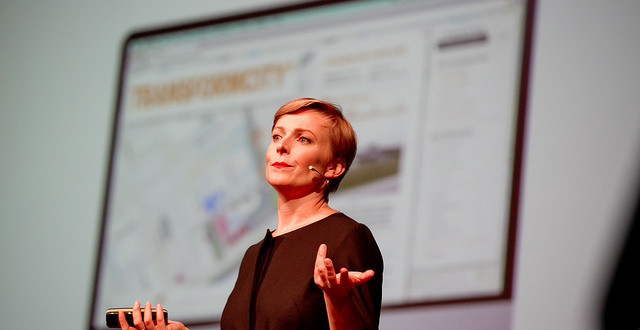
Photo: Saskia-Beer-color
How a Dutch architect became a role model for urban development
01 August 2017
Many of the greatest initiatives are born out of a crisis situation. Saskia’s amazing case is not different. When the financial and economic crisis of 2009 arrived, the Amsterdam area of Amstel3 hit a problem: as funds from the municipality dried up, the city’s large-scale redevelopment project got killed.
“The area was just lying there–full of outdated office spaces with a lot of vacancy. It was doomed to deteriorate further without action,”recalls Saskia Beer. That’s when she jumped in and developed what would soon become an international role model for grassroots urban development. “I couldn’t let the area die, so I simply adopted it and made it my baby.” Her goal was to reactivate and transform this outdated office district into a lively mixed-use neighbourhood.
The city was preoccupied with managing the economic crisis, so it was soon clear to Saskia that the change she envisioned would need to be initiated bottom up “together with all the local stakeholders”. So she started to get life and fun back into the area: Saskia hosted parties, organised a wide range of community events and used strong social media campaigns to tie the community together.
These playful real-world actions, like flower bulb planting and pop-up champagne parties built trust and enthusiasm. She had hit a nerve: the community kept growing with more and more people getting involved, planning events on their own and slowly bringing life back to the run-down area. When the community organised a highly successful crowdfunding campaign to build a community pavilion, the municipality of Amsterdam was so impressed with the developments that they decided to invest as well.

“Like a local community leader, we became an intermediate platform between bottom-up and top-down. More and more we facilitated a dialogue between the different stakeholders. Owners, renters, municipality, citizens … they all connected via our community. It was common that developers or real estate owners would ask me to connect them with municipal staff or with other initiatives. And the municipality asked us to make a new vision for the area in co-creation with the local community”, recalls Saskia.
However, the more the initiative–by then named ZO!City–grew, the more complex it became. At one point, the team simply could not handle the tasks of this ‘networking hub’ alone anymore.That was the moment when Saskia realised, they needed a tool to facilitate these complex processes. This led to the development of the innovative and prize-winning online urban planning platform TransformCity.
Saskia developed this platform so that everybody can share data, their ideas and initiatives for the area, project based alliances can be formed and resources shared and combined. Active engagement is rewarded. “It was crucial for us that everyone had access to the same information, in order for individuals or organisations to start their own projects. We effectively decentralised the information. This is the only way that sustainable collective ownership and self-organising power in the area amongst the stakeholders can become reality.”
TransformCity piloted in 2016 and had been a huge success since then. Hundreds of highly active citizens and organisations got involved, providing the Amstel3 area with a boost in activities. More than 50 cities from around the world are showing serious interest to implement TransformCity in their own communities as well.
Saskia left ZO!City to work full-time on the development and international scaling of TransformCity. “Just imaging how much impact this can have on communities around the globe. And it all started with just doing it …”
*****
TransformCity® dashboard is the smart technology spin-off from the community-based urban transformation activities that founder/CEO Saskia Beer has been developing in the pilot area in Amsterdam over the past five years.
Under the name ZO!City an integral process was built up, combining online with offline, bottom-up with top-down, serious with fun and social with smart.
Brought to you by Urban Future Global Conference









